US interfaith leaders leave Holy Land with deeper sense of possibilitiesPosted Feb 4, 2015 |
|
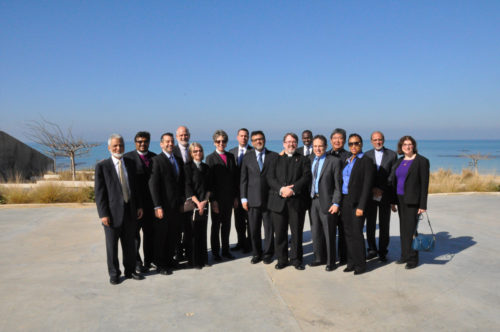
The interfaith delegation gathers for a group photo outside the Peres Peace Center in Jaffa, Israel, following a meeting with former Israeli Prime Minister Shimon Peres. Photo: Matthew Davies/ENS
[Episcopal News Service] A tapestry of words such as “vulnerability” and “fragility,” “courage” and “dignity” were woven into a common thread as Jewish, Christian and Muslim leaders from the United States concurred that they’d been transformed by a weeklong pilgrimage to the Holy Land. The experience, they said, would augment their responsibility to partners in Israel and the Palestinian Territories and inform the fabric of their future peacemaking work, both in the region and closer to home.
The 15-member interfaith group was co-led by Episcopal Church Presiding Bishop Katharine Jefferts Schori; Rabbi Steve Gutow, president of the Jewish Council for Public Affairs (JCPA); and Sayyid Syeed, national director of interfaith and community alliances for the Islamic Society of North America (ISNA).
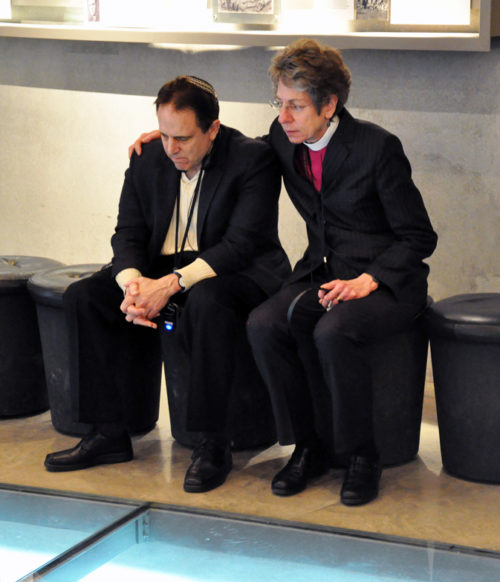
Episcopal Church Presiding Bishop Katharine Jefferts Schori and Rabbi Steve Gutow, president of the Jewish Council for Public Affairs, share a moment of quiet reflection during a visit to Yad Vashem, Israel’s memorial to the holocaust. Photo: Matthew Davies/ENS
The group held meetings with Israelis and Palestinians, decision-makers, high-level politicians, religious and civic leaders, and shared in one another’s faith traditions as they traveled for nine days in Israel, the West Bank, and Jerusalem. Stops included Tel Aviv, Nazareth, Safed, Tiberius, Ramallah, the West Bank settlement of Gush Etzion and its surrounding areas, and both east and west Jerusalem.
While extended meetings with Palestinian government officials necessitated cancellation of a group trip to Bethlehem, some pilgrims visited the West Bank city between other meetings. The full group toured the separation barrier in its route around Bethlehem and its environs in the West Bank. A group visit to Hebron was canceled because of last-minute schedule alterations as a winter storm approached the U.S. forcing some participants to change their departure plans.
(An ENS article about the group’s meeting with political leaders is available here.)
As the group reflected on the week, in conversation at the Palestinian-run hotel where they were staying inside the walls of Jerusalem’s Old City, Gutow described the journey as “a pilgrimage of relationship.

Rabbi Batya Steinlauf, director of social justice and interfaith initiatives for the Jewish Community Relations Council of Greater Washington, takes a photo of members of the Muslim delegation (from left) Mohamed Elsanousi, director of external relations for Finn Church Aid; Sayyid Syeed, national director of interfaith and community alliances for the Islamic Society of North America (ISNA); and Azhar Azeez, president of ISNA. Photo: Matthew Davies/ENS
“We thickened together as we traversed the holy soil of the holiest of lands. We saw the beauty of the place and we saw its pain. We grew in our understanding,” he said. “It is not the simple vision with which we entered the land but rather the complexity, the nuance, the stories (good and bad), the difficulties that now define our vision of what is there. Holiness takes a bit of work.”
Jefferts Schori said that the pilgrims’ “willingness to enter into deep conversation and both to teach and to learn in the interchanges will continue to resonate. I feel like we’ve had a taste of the eternal reality which our traditions seek.”
She also noted that, as an interfaith coalition, “we have a voice that can speak to political leaders, to other religious leaders, to other civic leaders. There is the potential to light some fires, in the best sense, around the United States, of hope and possibility if we speak together … May we be vessels and instruments of the peace of the Holy One.”
The Quran, Syeed said, “tells us that we have invested human beings with nobility and dignity, but that in order to maintain that dignity we have a certain responsibility. It’s very difficult for us to go back and lose sight of that dignifying process that God has set for us: to look into each other’s eyes, see that there is an image of God, and believe that we cannot allow ourselves to be degenerated, and we will not allow others to be degenerated. It is our collective duty to save each other.”

Members of the interfaith delegation tour the separation barrier in its route around Bethlehem. Photo: Matthew Davies/ENS
The visit was planned in response to Resolution B019, passed by the Episcopal Church’s General Convention in 2012, that called for positive investment and engagement in the region and recommended that the presiding bishop develop an interfaith model pilgrimage that experiences multiple narratives. That resolution reiterated the Episcopal Church’s longstanding commitment to a negotiated two-state solution “in which a secure and universally recognized State of Israel lives alongside a free, viable and secure state for the Palestinian people.”
The conflict between Israelis and Palestinians has lasted more than 60 years. U.S.-led peace negotiations between Israeli and Palestinian leaders broke down in May 2014, with both sides blaming the other for failing to make adequate concessions on issues such as borders, the status of refugees, the sharing of Jerusalem, and the construction of Israeli settlements on Palestinian land.
Alexander D. Baumgarten, director of public engagement and mission communication for The Episcopal Church, and one of the pilgrimage’s organizers, said: “It strikes me that narrative is a really complicated thing, because narrative is born out of our own levels of trust with the communities and the people and the realities with which we identify, for us as well as for Israelis and Palestinians. That is a wonderful thing in many ways but it is also fraught with danger, because in clinging to our own narratives … we might fail to see the authentic truth in another narrative.”
Bishop Prince Singh of the Episcopal Diocese of Rochester, a member of the Episcopal delegation, agreed. “We’ve not just celebrated our differences; we’ve moved into engaging more deeply the truths that each of us has grown with and has considered holy, but to be able to recognize it in another truth,” he said. “The various mirrors that have been presented have been a lot clearer because of this kind of transparency in community.”
Throughout the pilgrimage, Singh said that he’d found himself “going to deep places, which I cannot do if I’m not vulnerable. When we look at issues of justice, opinions can differ because of the lenses we use. But if, experientially, this is what beloved community can be, that gives me a lot of hope.”
The pilgrims said that the experience of journeying together as an interfaith community would also bear fruit when tackling pressing issues in their own contexts.
“I feel like God has thrown the pebble in the water and the ripples are just starting,” said Singh. “One such ripple for me is this template that can be applicable to peace on so many levels … One of the things I am taking away from here is to invite people into partnerships, and especially with the government, to see if we can figure out some solutions together, and if the faith communities can be helpful in the process … so that we can address some big issues like poverty and violence in our communities.”
Said Jefferts Schori: “I know there will be abundant opportunities for us to collaborate, in seeking healing in the Land of the Holy One, and in the nation we share in a different hemisphere. Peace building in one place impacts troubled and violent situations elsewhere.”
Members of the pilgrimage group have agreed to continue meeting now that they’re back in the United States, for the purpose of sharing trip reflections and recommendations with elected officials and to lead their own communities through an extended journey of shared advocacy, education and dialogue related to ending the Israeli-Palestinian conflict. According to Baumgarten, Episcopalians can expect to hear more about this in the months between now and when the 78th General Convention begins in Salt Lake City in June.
Sharing in one another’s faith traditions and learning about Jerusalem as a shared holy city through the eyes of other faith leaders brought a new dimension to the group’s understanding of the Jewish, Christian and Muslim histories and present context in the Holy Land.
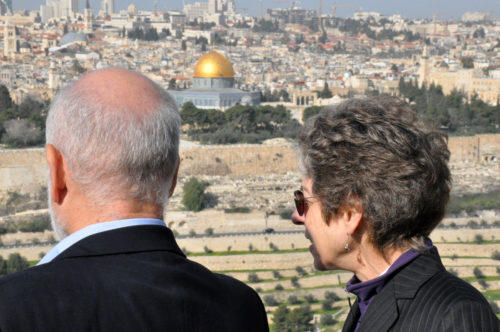
Episcopal Church Presiding Bishop Katharine Jefferts Schori and Rabbi Leonard Gordon, interreligious relations chair for the Jewish Council for Public Affairs, look out over Jerusalem from the Mount of Olives. Photo: Matthew Davies/ENS
“We knew that each of our traditions saw the face of God in those hills and valleys; we now know that all of our traditions see the face of God there,” Gutow said. “As we grew together, we were able to feel God’s presence in each of our hearts, not just our own. That is the gift. We understand even more than we did, and seeing God’s face in each other only deepens our responsibility to the land, to each other and, frankly, to God.”
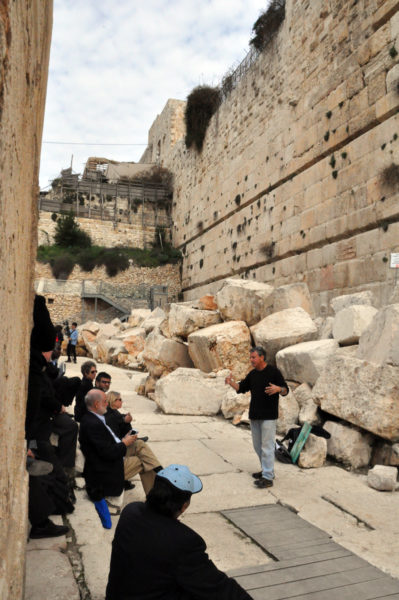
The interfaith group tours the archaeological excavations in the Old City of Jerusalem. Photo: Matthew Davies/ENS
Mohamed Elsanousi, director of external relations for Finn Church Aid in the U.S., and a member of the Muslim delegation, said that the fellowship among faiths “strengthening our relationships and building trust among us” has been a pivotal part of the trip, especially in deepening his understanding of the land and its meaning as the “sacred places of all the children of Abraham.”
He said the experience also would create space for more opportunities intended to further dialogue and deepen understanding among faiths in the U.S. “This visit has put responsibility on us … because we’ve been given this opportunity to understand” and to act, he said.
Syeed spoke of several U.S.-based initiatives and publications – facilitated by ISNA and its interfaith partners – to combat ignorance, misunderstandings and to change people’s preconceived notions about the Abrahamic faiths.
“We are talking about a fellowship that is determined to change the situation – a transformative fellowship – so that has to be on strong grounds,” said Syeed, with specific reference to two resource guides for interfaith dialogue, Sharing the Well and Children of Abraham.
The pilgrims also recognized that sharing this journey with such a diverse group of religious leaders presents certain challenges and shifts people outside of their comfort zones.
Rabbi Leonard Gordon, interreligious relations chair for the Jewish Council for Public Affairs, said that the pilgrimage has involved, “a certain amount of contraction, in our regular prayer routines, our regular eating routines, our regular routines of speaking our mind. We have been deferential to one another.”
Gordon acknowledged that there have been moments of tension and discomfort but recognized that “it is hard to be together and to be in this world of conflict that many of us speak about all the time, and we’ve had to be in this place of listening, but I think we’ve done it wonderfully.”
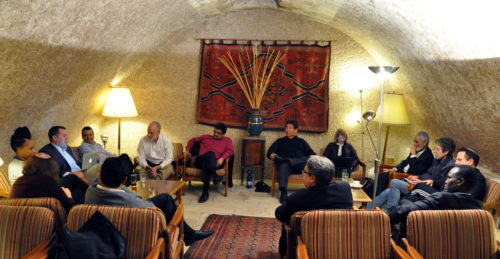
Members of the group reflect on the weeklong pilgrimage before returning home to the U.S. Photo: Matthew Davies/ENS
Sharon Jones, executive assistant to Presiding Bishop Jefferts Schori, was visiting the Holy Land for the first time. She said that the experience has been overwhelming but that she is returning to the United States with a new purpose and with a commitment to finding ways that she can respond.
Initial anxieties about spending a week with a new group of religious leaders and what she might be able to contribute to the pilgrimage were quashed after meeting everyone on the first evening. “I’ve felt community and I’ve felt a lot of trust, and we’ve shared so much.”
The Rev. Margaret Rose, deputy for ecumenical and interfaith relations for The Episcopal Church, said: “If we are pilgrims, we continue to be on that journey … We now need to determine what action should emerge, and that action really should require courage. I have experienced people here as being incredibly brave. So I pray for some bravery and courage to do some things that we haven’t done before.”
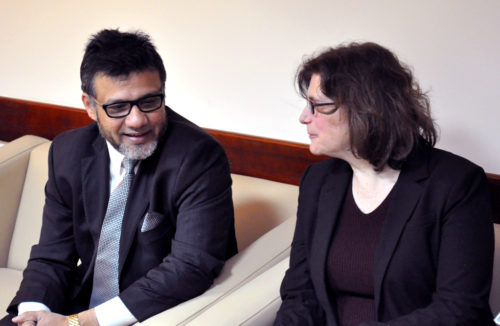
Azhar Azeez, president of the Islamic Society of North America, and Rabbi Batya Steinlauf, director of social justice and interfaith initiatives for the Jewish Community Relations Council of Greater Washington, in conversation ahead of meetings with Palestinian government officials. Photo: Matthew Davies/ENS
Rabbi Batya Steinlauf, director of social justice and interfaith initiatives for the Jewish Community Relations Council of Greater Washington, said that instead of looking at all of the things with which she is comfortable and familiar, she “looked up and out, and it felt really different because I am with a new community that sees from all these different perspectives. It touched me … I think a lot of what we’re trying to do is to see the world from God’s perspective, and I think that is one of the main messages we received: to remember that this belongs to God.”
Steinlauf noted that everyone the group met with “ultimately said that we are going to have hope and be optimistic … because you just have to be, and there’s a sense that, well there could be a miracle. To have such disparate views expressed and yet to hear that all are still holding out hope for a miracle, it’s nice to know that we are all working for one and with perseverance that we might actually get one.”
Azhar Azeez, president of the Islamic Society of North America, also spoke of seeing things from new perspectives, through the eyes of religious leaders, politicians, academics, authors and activists. “This land is a truly blessed land, but at the same time we find some huge challenges … It is very easy for me in America or anyone else in a Western society to talk about these issues, but the real challenges are faced by the people who live over here.”
Several members of the group said they had been moved and inspired by meetings with leaders of grassroots initiatives – the Shades Negotiation Program, EcoPeace and Roots – that bring together Israelis and Palestinians to hear and learn from one another’s narratives, and to build a peaceful society in which everyone can prosper.
“I was totally overwhelmed by the courage it took for each one of them,” said Gutow. “When you go against the tradition, whatever that tradition might be, when you go against your own people, when you’re willing to stand up and say, ‘this is not the right way to do it,’ that takes a certain kind of courage.”
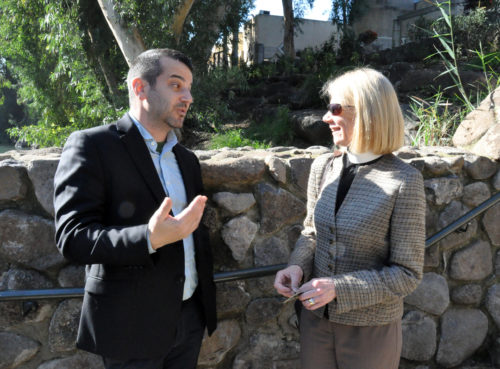
Ethan Felson, vice president and general counsel for the Jewish Council for Public Affairs, and the Rev. Margaret Rose, Episcopal Church deputy for ecumenical and interfaith relations, talk during a visit to the Yardenit Baptismal Site on the Jordan River. Photo: Matthew Davies/ENS
Ethan Felson, vice president and general counsel for the Jewish Council for Public Affairs, said: “In a time when there is so much energy devoted to smashing one side or another, it was enriching to experience true peacemakers at work on the ground smashing their own comfort zones, and to travel among peacemakers doing the same thing.”
The people who are doing the most transformative work, Felson said, “aren’t the ones who are focused on a document or on policies or on calling out something, but rather about remaining where they are in their community in that authentic place and meeting others who similarly remain in that authentic place, and really embracing a different understanding of what it means for two people with different narratives to come to live alongside one another.”
The Rev. John E. Kitagawa, rector of St. Philip’s-in-the-Hills Episcopal Church in Tucson, Arizona, said: “We’ve heard from these incredible voices of people who are really putting themselves on the line, looking at themselves so intently, being able to make those conversions of heart. I am leaving in a more hopeful place than I thought I would be.”
In summing up the pilgrimage, Baumgarten said, “What I’ve been encouraged by on this trip was seeing that, especially away from the spotlight, Israelis and Palestinians really are challenging their communities to walk by a different road, and I think that now, in going home, we really are challenged to challenge our own communities to walk by another road.”
Baumgarten drew on the T.S. Eliot poem The Journey of the Magi, in which Eliot writes in the voices of the wise men, “We returned to our places, these Kingdoms. But no longer at ease here, in the old dispensation.”
“That’s how I feel as an outcome of this trip,” said Baumgarten. “I feel that if everyone could come here and walk the road we’ve walked together, none of us would be at ease in our old dispensation.”
– Matthew Davies is an editor/reporter of the Episcopal News Service.

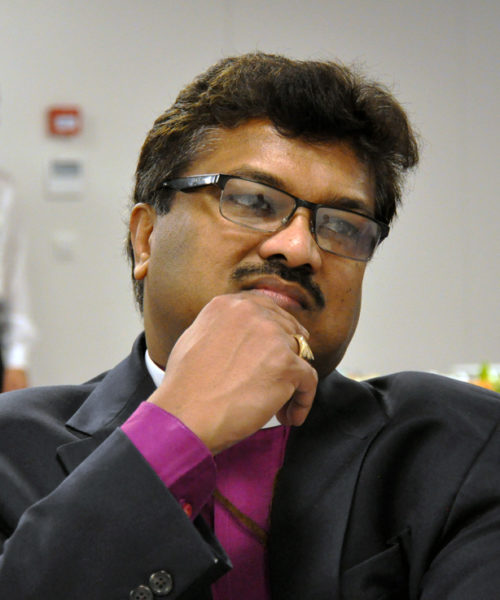
Social Menu